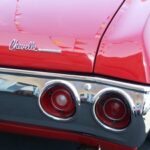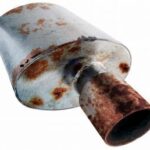Does your car need a new paint job, but you can’t afford the high prices that body and paint shops charge? You can save money by doing the prep work yourself at home. This article is not intended to teach you everything you need to know to paint your own car. It is intended to be a simple guide to detail the steps you take to get your car ready to paint.
I’m not going to get into the details of body repair such as welding, fillers, etc. This article is for the car that has no dents, rust, etc. or for cars that have already had the bodywork completed.
The first step is to remove as much of the trim as possible from over and around the areas to be painted. This means trim, bumpers, mirrors, grille, and other exterior items. Remember how everything comes off, because you will have to put it all back on later.
The next step is to thoroughly clean your car. I recommend washing it with a bucket of water mixed with Dawn dish washing detergent. Dawn is the best most inexpensive way to remove grease and oil from the car’s surface. Rinse thoroughly with clean running water. Towel dry.
It might be best to apply a thick layer of tape to any areas that have not have been removed, like the windshield molding. This will protect these areas from the sanding you’ll be doing next.
Sand down the old paint. A 180 grit sandpaper is best for this. Sand it as smooth as possible, taking the paint down far enough to remove any pits and scratches. The best way to do this is by using a dual-action (DA) orbital air sander, which is less likely to dig in than other sanders. Avoid using the DA too close to trims and chrome. You will have to hand sand these areas. Fold a piece of your sandpaper in half and sand any areas that were missed, holding the paper flat under your hand. Avoid using excess pressure of the fingertips. Now remove any tape that you applied.
Using your air hose, blow all the sanding dust off the car, making sure to pay close attention to all crevices and grooves. Now it is time to mask off the car for the primer coat. Using masking tape and paper, cover anything that should not be painted, like chrome, mouldings, windows, door handles and locks. Make sure you also mask off the tires. This can be done by taking large plastic garbage bags and ripping open the side about 3/4 of the way up, then slip them over the top of the tire.
Now do one more wipe-down just prior to applying the primer/filler coats. Apply several thin coats of a quality sandable primer/filler to the entire car. Allow this to dry completely (according to manufacturing directions on can.)
Wet sanding of the primer is done with 400 grit wet/dry sandpaper. For flat areas, use a rubber pad (block sanding). Use a bucket of warm clean water and a sponge to keep your sanding area wet. Sand back and forth until all areas are smooth. Finish water sanding any areas that the block cannot get to by hand with the 400 grit paper and water. Remember, the smoother the surface is, the smoother the paint will go on later. Remove all masking tape and paper now.
When done, clean the car thoroughly with clean water, and wipe the car dry to prevent contaminants in the water from being left on the primer.
Now you are ready to find the paint shop you want to take your car to. I recommend going to several of them and actually looking at a car that they have painted. You will be able to judge the quality of their work and decide if that is what you want your car to look like.
If you want to save even more money, buy all the paint supplies yourself and take them with you. Make sure you check with the body shop that will be doing the painting to see if they know how to spray the brand you choose.
Overall, doing the prep work and buying the materials yourself will save you a lot of money. You will only have to pay someone to do the final masking and paint.




